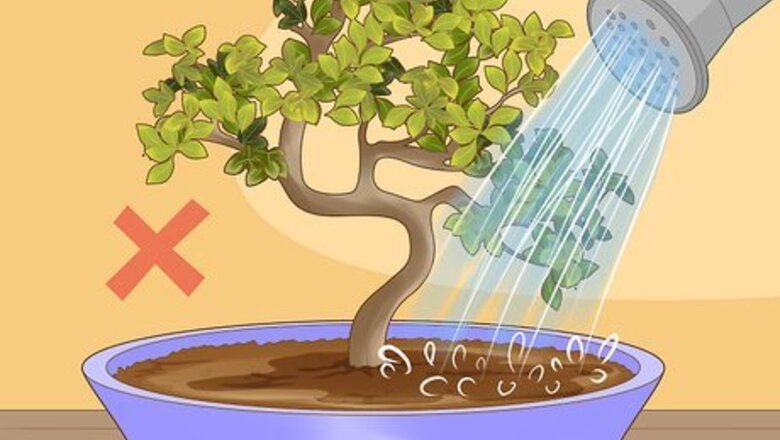
views
- Water your bonsai less often if the leaves are becoming discolored or wilting.
- Water the tree more often if the leaves are suddenly falling off.
- Transfer your bonsai into a well-drained pot, while trimming away any withering roots.
- Apply small amounts of rubbing alcohol to any molding leaves, and spray the tree with pesticide to get rid of pesky insects.
Treating Common Issues
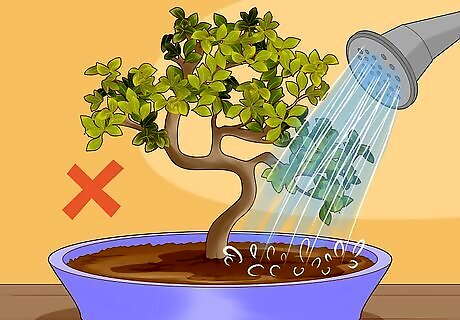
Water your bonsai less often if the leaves are slowly discoloring. If the leaves on your bonsai tree are gradually wilting and turning yellow, reduce the amount of water that you give your tree. When the leaves slowly turn yellow and die, this is usually a sign that you’re overwatering your plant and the roots are starting to rot. How often you’ll need to water your bonsai varies greatly from one plant to another, regardless of the species. It may take a bit of trial and error for you to figure out how often your specific plant needs to be watered.
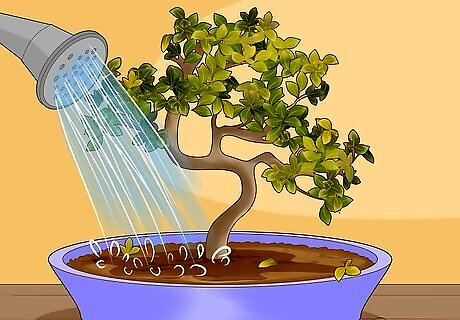
Add water to the soil more often if the leaves yellow and fall suddenly. If the leaves on your bonsai start to die quickly, usually within a few days, water your tree as soon as the top of the soil appears dry. Bonsai trees are very sensitive to their environment, so any changes can affect how much water your plant needs at a given time. If the branches and trunk start to shrink, this may also indicate that your Bonsai is drying out and needs more water.
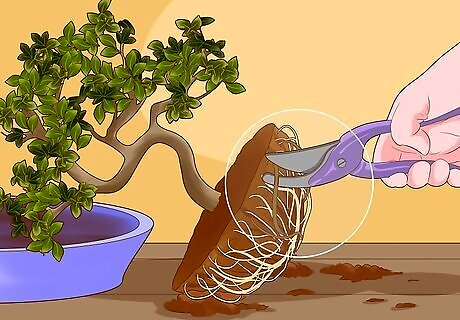
Remove the diseased roots if your bonsai has root rot. If your bonsai leaves are discolored or your plant has a bit of a rotten smell, carefully lift the tree out of its pot to examine the roots for root rot. If any the roots appear shriveled and dead or smell rotten, use pruning shears or a sharp knife to cut the dead roots from the plant before repotting your bonsai. If your bonsai is struggling but you don’t smell anything by sniffing the top of the soil, try sniffing through the drainage hole to see if there’s a rotten smell. In addition, try scratching the roots with a sharp knife to see if they’re still green inside. If they’ve turned brown, they’re likely rotten and need to be removed.
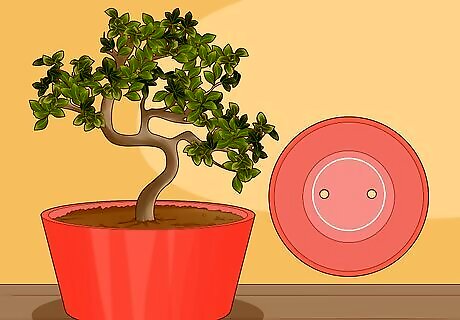
Transfer your bonsai into a pot with 2 drainage holes. If you reduce how often you water your bonsai and it’s still struggling, transfer your bonsai into a new pot with 2 drainage holes. This helps the soil drain out excess water and nutrients, as well as filter out any bacteria that could otherwise cause an infection. While you should avoid repotting your bonsai tree more than once per year if possible, it’s best to go ahead and repot it if the leaves continue to wilt or turn yellow, brown, or black, or if the roots are shriveling and dying due to a fungal or bacterial infection. Repot your tree in bonsai potting soil or a mixture of potting compost, sand, and pebbles to help with aeration and drainage.
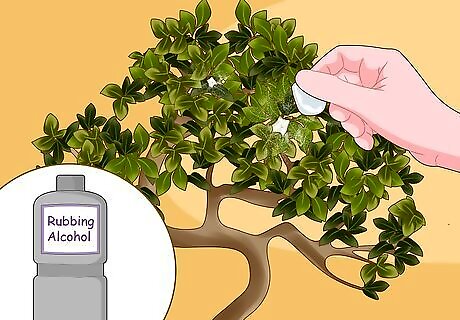
Dab the infected area with rubbing alcohol if you see mold. If your bonsai is struggling, examine it to see if there are any fuzzy white spots on the leaves, branches, or stem. If you see signs of mold, dip a cotton ball in rubbing alcohol and dab it on the infected area. Make sure that you don’t rub or wipe, which could spread the fungal infection. Use a new cotton ball for each leaf, stem, or branch to avoid spreading the mold. If you spot mold on your tree during the winter months when the tree is dormant, you can also prune your tree to remove the infected areas.
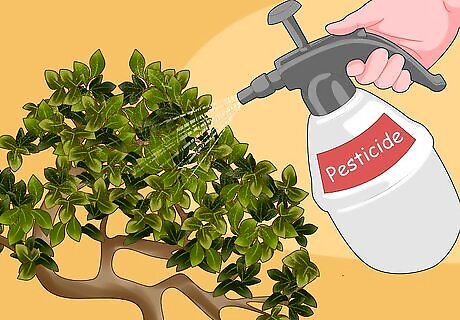
Use a pesticide to get rid of a pest infestation. If you notice any small white dots, fuzzy white substances, or pests on your bonsai tree, spray the infested areas with an insecticide spray to kill the pests. You can generally use an indoor all-purpose insecticide spray or use an insecticide specifically made to kill the type of pest your tree is infected with. How you’ll apply the insecticide varies depending on the type of insecticide and the type of pest. Read the instructions for the specific insecticide you’re using. The most common pest infestations on bonsai trees are aphids, red spider mites, scale insects, caterpillars, vine weevils, and mealy bugs. Scale insects and spider mites can also be killed by dabbing the infested areas with rubbing alcohol.
Providing the Right Care and Conditions
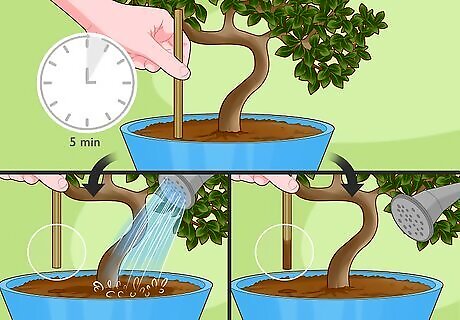
Check the soil with a wooden stick before watering your bonsai. To test if your bonsai needs to be watered, stick a wooden stick, such as an unused popsicle stick or a chopstick, into the soil. Leave the stick in the soil for about 5 minutes, then pull it back out. If the stick is dry, water your bonsai. If the stick is visibly damp, wait another day or so before repeating this process to check the soil moisture again. You can also use a moisture meter tool to assess the soil moisture levels. These are available online and at many plant supply stores.
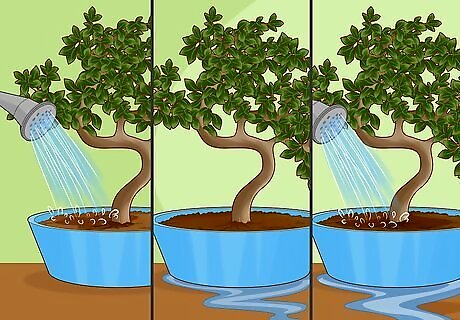
Water your bonsai twice to make sure it gets enough water. First, water your bonsai until the soil is completely moistened. Wait a few minutes to allow it to drain, then water your bonsai again. Allow it to drain again before returning the pot to its dish. Most bonsai trees are planted in a clay-like soil that doesn’t absorb water quickly. By watering it twice, the soil will have more time to absorb the water the bonsai needs to thrive.

Place your bonsai so it gets about 5 hours of sunlight per day. Certain bonsai species require direct sunlight, while others need indirect sunlight to keep their leaves from burning. Therefore, make sure that you position your plant according to what your specific species requires. For example, Juniper bonsai trees, the most popular bonsai species, should get about 5 hours of direct sunlight in the morning, then moved into the shade in the afternoon. Ficus bonsai trees, another popular species, can thrive in both direct and indirect sunlight.
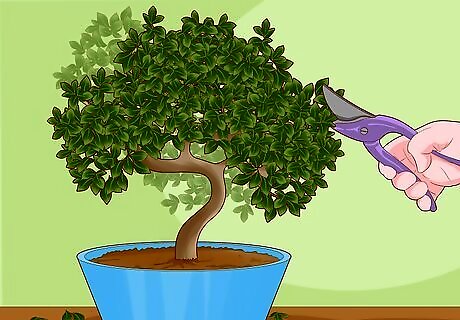
Prune your bonsai tree if you want it to keep its shape. Using sharp pruning shears, cut away any new shoots and leaves that change the shape of your tree. Pruning any undesirable new growth on your tree encourages your bonsai to sprout smaller branches that are easier to shape and maintain. In general, substantial pruning should be done in the winter while your bonsai is dormant. However, if you have a flowering bonsai and you want to encourage the tree to bloom more flowers the following year, prune the buds in the spring.
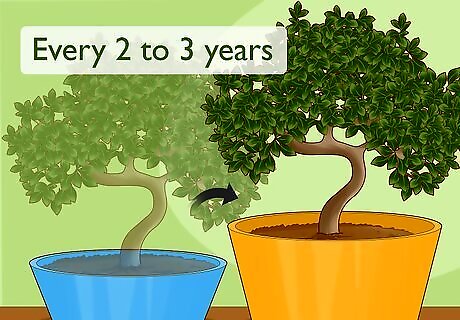
Repot your bonsai in late winter every 1 to 3 years. While it varies a bit from one species to another, most bonsai trees need to be repotted every year for the first few years and every 3 years once they’re matured after that. Although you can repot your bonsai any time of year if it’s struggling, it’s generally best to transfer it to a new pot at the end of its winter dormant period and just before its spring growing season. Because bonsais are meant to remain small, you usually won’t need to use a bigger pot. You can repot your bonsai in the same pot after cleaning it and adding new bonsai soil, or transfer it to a new pot with better drainage if your plant is struggling. Repotting your bonsai keeps the soil fresh and makes it less likely to develop a fungal or bacterial issue.
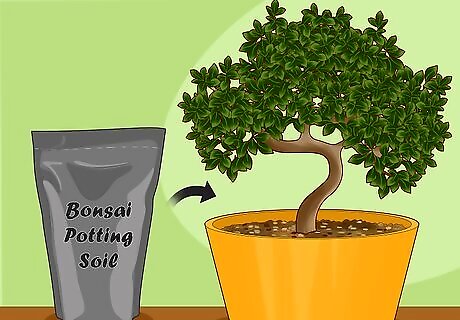
Use a bonsai potting soil to keep your bonsai healthy. When you’re repotting your bonsai tree, choose a potting soil specifically designed for bonsai trees for best results. Because they grow in small spaces and need to both retain water and have good drainage, it can be difficult to mix your own bonsai soil that suits your tree’s needs. Choosing a bonsai potting soil is generally your best bet. If you want to try to mix your bonsai soil, try mixing 2 parts akadama for every 1 part pumice and 1 part lava rock. The akadama helps retain moisture while the pumice and lava rock provides good drainage and aeration.
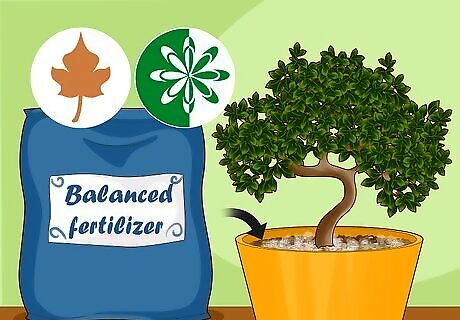
Add a balanced fertilizer to the soil during the spring, summer, and fall. To help your bonsai revive and keep it healthy once it’s on the mend, add a fertilizer with equal parts nitrogen, phosphorous, and potassium throughout the bonsai’s growing season. You can use either a solid or liquid fertilizer as long as the ingredients are balanced. The amount of fertilizer you’ll need to use varies depending on the type of bonsai tree you have and the type of fertilizer you’re using. Read the instructions on the fertilizer bottle to determine how much to use and how often to add it to the soil.


















Comments
0 comment